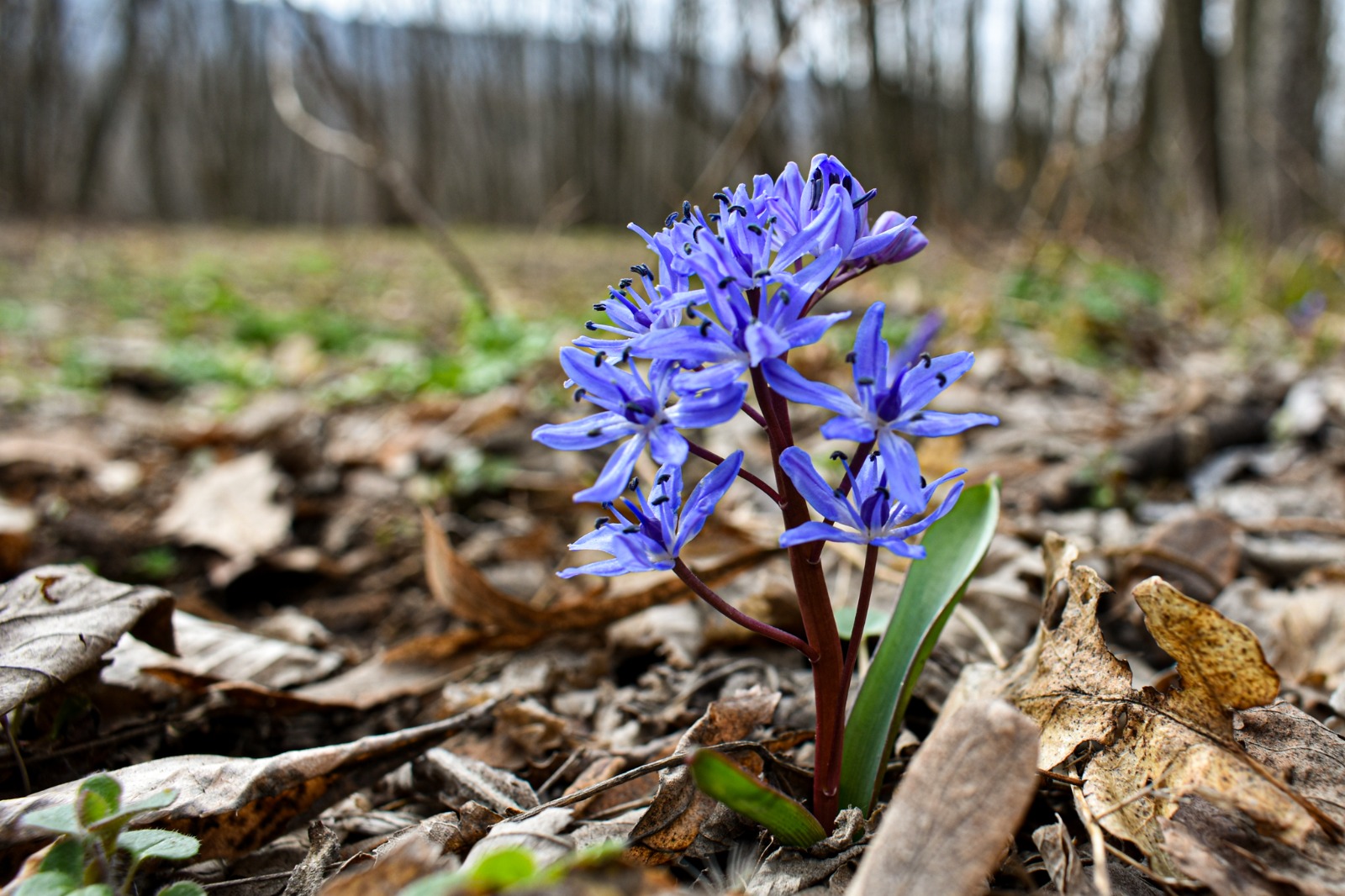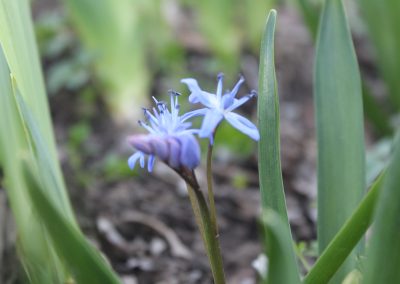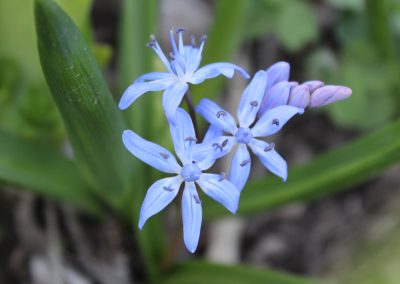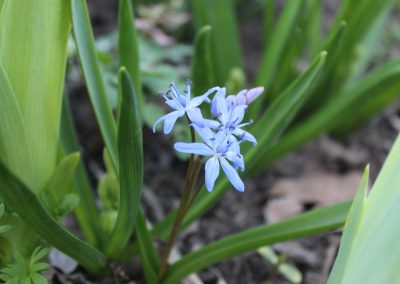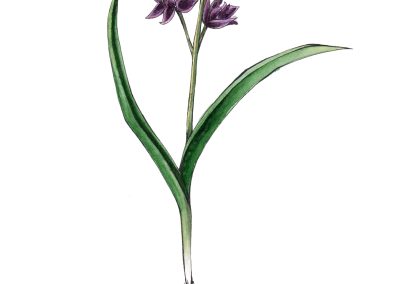Scilla bifolia
Scientific description
Phylum: Angiospermatophyta (Magnoliophyta)
Class: Monocotyledonatae (Liliatae)
Order: Asparagales
Family: Asparagaceae
Common name: Alpine squill, two-leaf squill.
Origin: European.
Description:
A perennial herbaceous plant, geophyte, with a small bulb wrapped in brown tunics. It develops two basal, lanceolate, bright green leaves. The inflorescence is a raceme with 6–12 flowers, each on a pedicel. The flowers are actinomorphic, with 6 blue tepals forming a star-shaped corolla. The androecium consists of 6 stamens with blue filaments inserted at the base of the tepals. The gynoecium has a superior ovary, trilocular, with a short style and capitate stigma. It blooms very early, from March to April, being among the first spring flowers. The fruit is a capsule.
Propagation: by seeds and bulb division.
Ecology:
It grows in deciduous forests, forest edges, and meadows, from lowlands to hilly and submontane areas. It prefers moist and humus-rich soils.
Uses:
Ornamental plant, cultivated in gardens and parks for its early flowering. It also has importance for pollinators, providing nectar and pollen at the beginning of spring.
Încrengătura: Angiospermatophyta (Magnoliophyta)
Clasa: Monocotyledonatae (Liliatae)
Ordinul: Asparagales
Familia: Asparagaceae
Denumire populară: viorea, scilla alpină.
Originea: europeană.
Descrierea:
plantă erbacee perenă, geofită, cu bulb mic învelit în tunici brune. Prezintă două frunze bazale, lanceolate, verzi-lucioase. Inflorescența este un racem cu 6–12 flori, fiecare pe pedicel propriu. Florile sunt actinomorfe, având 6 tepale albastre, stelate. Androceul este format din 6 stamine cu filamente albastre inserate la baza tepalelor. Gineceul prezintă ovar super, trilocular, cu stil scurt și stigmat capitulat. Înflorește foarte timpuriu, din martie până în aprilie, fiind una dintre primele flori de primăvară. Fructul este o capsulă.
Înmulțire: prin semințe și diviziunea bulbilor.
Ecologie:
crește în păduri de foioase, margini de pădure și pajiști, de la câmpie până la zonele de deal și submontane. Preferă solurile umede și bogate în humus.
Utilizare:
plantă ornamentală, cultivată în grădini și parcuri datorită înfloririi timpurii. Are și importanță pentru polenizatori, oferind nectar și polen la începutul primăverii.
Φύλο: Angiospermatophyta (Magnoliophyta)
Κλάση: Monocotyledonatae (Liliatae)
Τάξη: Asparagales
Οικογένεια: Asparagaceae
Δημοφιλές όνομα: σκίλλα, διφύλλια σκίλλα.
Καταγωγή: Ευρώπη.
Περιγραφή:
Πολυετές ποώδες φυτό, γεώφυτο, με μικρό βολβό περιβαλλόμενο από καστανόχρωμες χιτώνες. Έχει δύο βάσιμα λογχοειδή, γυαλιστερά πράσινα φύλλα. Η ταξιανθία είναι βότρυς με 6–12 άνθη σε ποδίσκους. Τα άνθη είναι ακτινόμορφα, με 6 μπλε τεπάλια σε σχήμα αστεριού. Το ανδρείο αποτελείται από 6 στήμονες με μπλε νήματα, προσκολλημένα στη βάση των τεπαλίων. Το γύνοικo έχει υπέρoχη ωοθήκη, τρίχωρη, με βραχύ στύλο και κεφαλωτό στίγμα. Ανθίζει πολύ νωρίς, Μάρτιο–Απρίλιο. Ο καρπός είναι κάψα.
Πολλαπλασιασμός: με σπόρους και διαίρεση βολβών.
Οικολογία:
Αναπτύσσεται σε φυλλοβόλα δάση, άκρες δασών και λιβάδια, από πεδινές έως ημιορεινές περιοχές. Προτιμά υγρά και πλούσια σε χούμο εδάφη.
Χρήσεις:
Καλλωπιστικό φυτό, καλλιεργείται σε κήπους και πάρκα λόγω της πρώιμης άνθισης. Σημαντικό για τους επικονιαστές, παρέχει νέκταρ και γύρη νωρίς την άνοιξη.
Phylum : Angiospermatophyta (Magnoliophyta)
Classe : Monocotyledonatae (Liliatae)
Ordre : Asparagales
Famille : Asparagaceae
Noms communs : scille à deux feuilles, scille alpine.
Origine : européenne.
Description :
Plante herbacée vivace, géophyte, à petit bulbe entouré de tuniques brunes. Elle porte deux feuilles basales lancéolées, vert brillant. L’inflorescence est une grappe de 6 à 12 fleurs pédicellées. Les fleurs sont actinomorphes, à 6 tépales bleus formant une corolle étoilée. Androcée : 6 étamines aux filets bleus insérés à la base des tépales. Gynécée : ovaire supère, triloculaire, style court, stigmate capitulé. Floraison très précoce, de mars à avril, parmi les premières fleurs printanières. Le fruit est une capsule.
Propagation : par graines et division des bulbes.
Écologie :
Présente dans les forêts de feuillus, lisières et prairies, des plaines aux zones collinaires et submontagnardes. Elle préfère les sols frais et riches en humus.
Usages :
Plante ornementale cultivée dans les jardins et parcs pour sa floraison précoce. Importante aussi pour les pollinisateurs, fournissant nectar et pollen dès le début du printemps.
Creative writing inspired by Scilla bifolia
Written by
Vlad Jasmina
Andrada-Alexandra Lica
The Girl Who Returned as a Flower
Long ago, on the edge of an ancient forest where the trees seemed to carry the memories of every season deep within their trunks, there lived a girl named Viora. Her hair was as black as a storm cloud’s shadow, and her eyes were so deeply blue that one might think the forest had dreamed her into life from a sliver of clear sky. Her parents, two gentle and humble souls, loved her dearly. She was their only child — the answer to a prayer whispered during a harsh winter, when her mother feared her heart would never again beat for a child.
Viora was quiet, but her silence was full of wonder. From an early age, she wandered into the woods alone, walking for hours with no fear. She said the forest called her, that the air there was sweeter, and the leaves knew her name. Her parents watched her go, saying nothing, but always with a subtle worry in their eyes — as if they sensed that part of her already belonged to the forest.
One spring, late and reluctant after a bitter winter, Viora rose early and said:
“Something is shifting today. I’m going deeper into the forest. I think Spring is hiding among the shadows.”
“Be careful,” her father said. “The forest is not always kind.”
“If I don’t return today,” she smiled, “know that I haven’t been lost. I’ve only changed.”
She braided her hair, took her shawl, and disappeared into the trees. She never came back.
Days passed. The villagers searched. Her parents called until their voices broke. But the forest remained silent — as if it had swallowed her whole, without a trace.
Then, in a clearing where Viora used to sit and gaze at the sky, tiny blue flowers appeared for the first time. They grew in pairs, delicate yet brave, with slender stems and petals that shimmered like her eyes. None of the elders had seen anything like them.
Her mother fell to her knees and whispered through tears, “She didn’t leave. She became the forest.”
The villagers named the flower scilla, and in time, they called it Viora’s bloom. It is said that if you touch it gently, the flower shivers — as if it still remembers. And if you gaze at it long enough, you’ll feel a sweet, quiet longing, like a memory from a life you never lived but still carry in your soul.
And so, each spring, when the snow begins to melt and silence still holds the land, Viora returns. Not in footsteps or voice, but in the bloom of a flower that loved the forest — and stayed.


